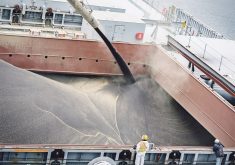High protein is like gold in U.S. wheat markets.
Wheat prices generally are dropping, but the highest protein wheat is falling by the least amount in the latest Canadian Wheat Board Pool Return Outlook for 2009-10.
“There’s not a lot of it trading, but the bids are still out there,” said Fargo, North Dakota, grain analyst and broker Mike Krueger.
He said 15 percent protein wheat has recently traded for $5 per bushel over Minneapolis Grain Exchange futures prices, an incredible spread. Thirteen percent protein wheat is trading for only 20 to 25 cents over Minneapolis futures.
Read Also

Russian wheat exports start to pick up the pace
Russia has had a slow start for its 2025-26 wheat export program, but the pace is starting to pick up and that is a bearish factor for prices.
“The bins here are filled with 12 percent protein wheat,” he said.
The March 25 2009-10 PRO reflects the strong market for high protein wheat. Although No. 1 Canadian western red spring wheat 14.5 percent protein fell from $7.21 per bushel to $7.10 in the last month, that 11 cent fall is less than the 14 cent per bu. decline in 13.5 CPRS from $6.64 to $6.48, and still less than the 16 cent drop for 12.5 CPRS.
There is little high protein wheat left in North America. Last summer’s crop was hurt by bad weather and is mostly made up of lower protein wheat. Buyers are having to bid high to get the small supply, and prices may have to rise more to get what is left.
“They’re still not paying enough of a premium to get the doors open,” said Joe Victor, a market analyst with Allendale, Inc., of McHenry, Illinois.
Millers and food processors need high protein wheat for certain products and to blend into lower protein wheats for bread.
Krueger said one buyer of high-priced wheat said they needed the high protein wheat to cover a delivery obligation.
Canadian Wheat Board market analyst Bruce Burnett said the huge spread between high and lower protein wheat may not last much longer.
“What’s going to happen to these spreads as we move towards new crop U.S. (wheat crops this summer and fall)?” said Burnett.
“Our assumption, when you look at the PRO, is that the wide protein spreads narrow in somewhat.”
The 2010-11 PRO for March shows high protein falling as much as lower protein. The board has to assume a normal U.S. crop and a normal world crop when it makes it projections.
Krueger said problems in the U.S. hard red winter area of Texas, Oklahoma, Kansas and Nebraska – a wet and cold winter – give hope to spring wheat growers that protein premium spreads could stay high.
“It could be a very low protein hard red winter crop,” said Krueger. “The protein problem may not go away.”
Victor said buyers now are not bidding up protein premiums for new crop months, but may if they get scared.
“For new crop they’re keeping their fingers crossed,” said Victor.
North Dakota farmers are already gambling on the protein spreads continuing, he said. Farmers are buying up varieties that produce higher protein rather than higher yields.















